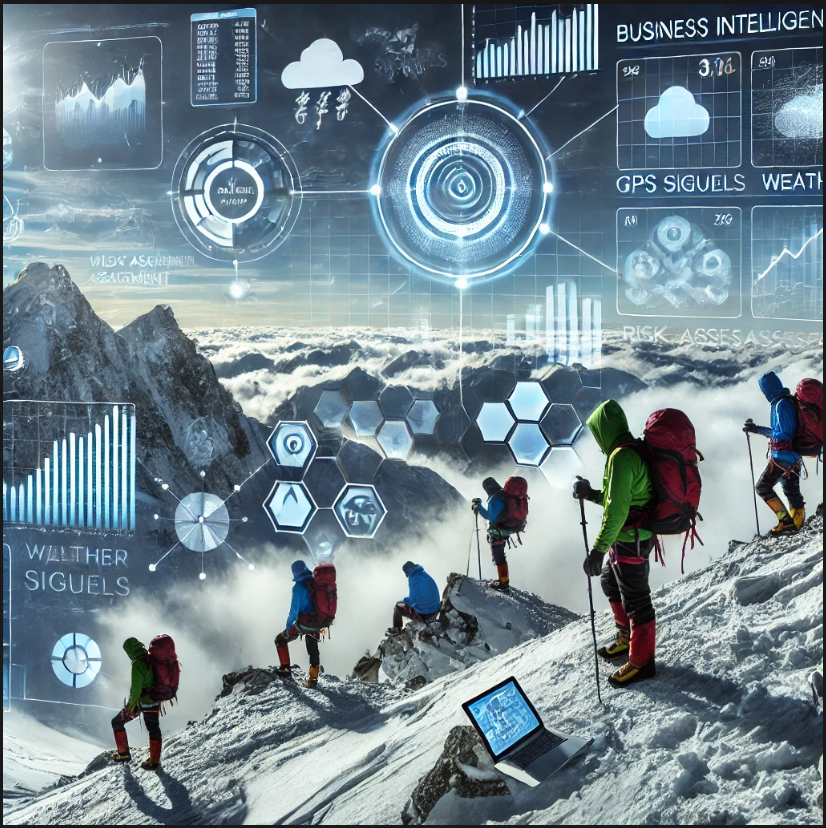Mountain climbing is an exhilarating yet risky activity, requiring careful planning and constant vigilance. Safety is paramount in this extreme sport, and thanks to technological advancements, business intelligence aids in mountain climbing safety more than ever before. In this article, we’ll explore how integrating business intelligence (BI) can drastically improve safety measures for climbers, both amateur and professional, by analyzing data, predicting risks, and facilitating real-time decision-making.
The Role of Business Intelligence in Enhancing Mountain Climbing Safety
Business intelligence (BI) refers to the tools, systems, and technologies that help businesses make data-driven decisions. In recent years, BI has extended beyond corporate environments and is increasingly being applied in industries where safety is a concern. Mountain climbing is one such area, where weather patterns, terrain analysis, equipment failure rates, and climber health data can all be tracked and analyzed to reduce risks.
Using business intelligence in mountain climbing safety can involve a range of applications, from wearable technology that monitors a climber’s vital signs to predictive models that forecast the likelihood of avalanches. These tools provide climbers and guides with actionable insights, helping them make informed decisions that can be the difference between life and death.
How Business Intelligence Aids in Mountain Climbing Safety
The integration of business intelligence systems in mountain climbing safety involves collecting, analyzing, and interpreting massive amounts of data. Here’s how BI directly contributes to safer climbing experiences:
- Data Collection from Wearable Devices: Modern climbers are often equipped with wearable devices like smartwatches or GPS trackers. These devices can gather critical information, such as heart rate, oxygen levels, altitude, and even real-time weather updates. By syncing this data with BI systems, climbers can receive early warnings if their vitals are outside safe ranges or if weather conditions are rapidly changing.
- Risk Prediction Models: Machine learning algorithms within BI platforms can predict potential risks based on historical data. For instance, by analyzing previous climb data from similar expeditions, BI can predict the likelihood of avalanches, rock falls, or extreme weather conditions. These predictive models are constantly refined as new data becomes available, providing climbers with up-to-date safety information.
- Route Optimization and Terrain Analysis: Business intelligence systems can analyze the terrain and recommend safer climbing routes. These systems use satellite imagery, topographical maps, and past expedition data to find the best paths that avoid known hazards. By optimizing routes, climbers can not only increase their chances of success but also avoid dangerous areas prone to accidents.
- Real-Time Communication: Communication in mountainous regions is often limited due to the remote nature of the locations. However, business intelligence systems can integrate with satellite communication devices, allowing climbers to stay in touch with their base camp or rescue teams. In case of emergencies, real-time data on the climber’s location, weather conditions, and vitals can be transmitted to response teams, facilitating faster rescues.
- Emergency Response and Medical Support: When a climber faces a medical emergency, every second counts. BI systems can assist emergency response teams by providing detailed information about the climber’s location, health, and environmental conditions. Furthermore, wearable devices integrated with BI systems can detect health issues such as altitude sickness or exhaustion before they become life-threatening, allowing for preventative measures to be taken.
Key Benefits of Business Intelligence in Mountain Climbing
- Increased Safety: The primary benefit of business intelligence in mountain climbing is improved safety. By leveraging data-driven insights, climbers can avoid unnecessary risks and make informed decisions based on real-time information.
- Better Planning: Before embarking on a climb, BI tools help with meticulous planning. Climbing teams can study weather forecasts, analyze previous climbing data, and identify the safest routes.
- Improved Response Times: In the event of an accident, BI systems significantly reduce response times by providing rescuers with real-time information about the climber’s condition and location.
- Enhanced Decision-Making: BI tools enable climbers and their guides to make better decisions while on the mountain. With continuous data flow, climbers can adjust their plans based on changing conditions and personal health.
The Future of Business Intelligence in Mountain Climbing Safety
The application of business intelligence in mountain climbing safety is still evolving. As technology improves, the potential to increase safety further becomes even greater. One area of growth is the use of artificial intelligence (AI) to not only predict risks but also offer proactive solutions. For example, AI could potentially suggest alternative routes in real-time, based on changing weather conditions, or recommend equipment adjustments depending on terrain.
Furthermore, the integration of drones with BI systems can enhance safety even further. Drones can scout ahead, capture real-time video footage, and provide climbers with insights about upcoming terrain or potential hazards. These drones can also serve as communication relays, improving connectivity between climbers and base camps in remote areas.
Another future possibility is the incorporation of BI with virtual reality (VR) for pre-climb training. Before climbers even set foot on the mountain, they can practice their routes in a virtual environment, gaining familiarity with the terrain and potential hazards.
Challenges of Implementing Business Intelligence in Mountain Climbing
While business intelligence offers numerous advantages, implementing these systems in the context of mountain climbing presents challenges:
- Technical Limitations in Remote Areas: The lack of reliable internet access in mountainous regions can limit the effectiveness of real-time data collection and transmission.
- High Costs: The technology involved in deploying business intelligence systems, such as wearables, satellite communication devices, and drones, can be expensive, making it less accessible to all climbers.
- Data Overload: With so much data available, climbers may experience information overload, which could slow decision-making in critical moments.
Despite these challenges, the benefits of BI in ensuring mountain climbing safety far outweigh the obstacles. As the technology becomes more refined and affordable, we can expect to see greater adoption of BI tools in outdoor sports, particularly in mountain climbing.
Conclusion
Business intelligence aids in mountain climbing safety by providing real-time insights, predictive risk analysis, and improved communication systems. Through the use of wearable technology, data analytics, and advanced communication tools, climbers are better equipped to tackle the risks associated with extreme altitudes. As BI technology continues to evolve, it will play an increasingly crucial role in making mountain climbing a safer sport for adventurers worldwide.
FAQ
Q: How does business intelligence help predict avalanches?
A: Business intelligence systems use historical data on weather conditions, snowpack, and previous avalanches to create predictive models. These models can forecast the likelihood of an avalanche based on current conditions.
Q: Can business intelligence improve communication in remote mountain areas?
A: Yes, BI systems can integrate with satellite communication devices, enabling real-time data transmission even in remote areas where traditional communication methods might fail.
Q: Are BI tools accessible to amateur climbers?
A: While BI tools can be expensive, many companies are developing more affordable solutions. Amateur climbers can also use simpler BI systems, like wearable devices that provide basic health and weather information.
Q: What types of data are analyzed in BI systems for mountain climbing?
A: BI systems analyze data from wearable devices, weather forecasts, terrain maps, and historical climbing data to help predict risks and improve safety decisions.
By leveraging these advanced tools, the future of mountain climbing looks much safer, ensuring that adventurers can focus more on the climb and less on the dangers that come with it.



